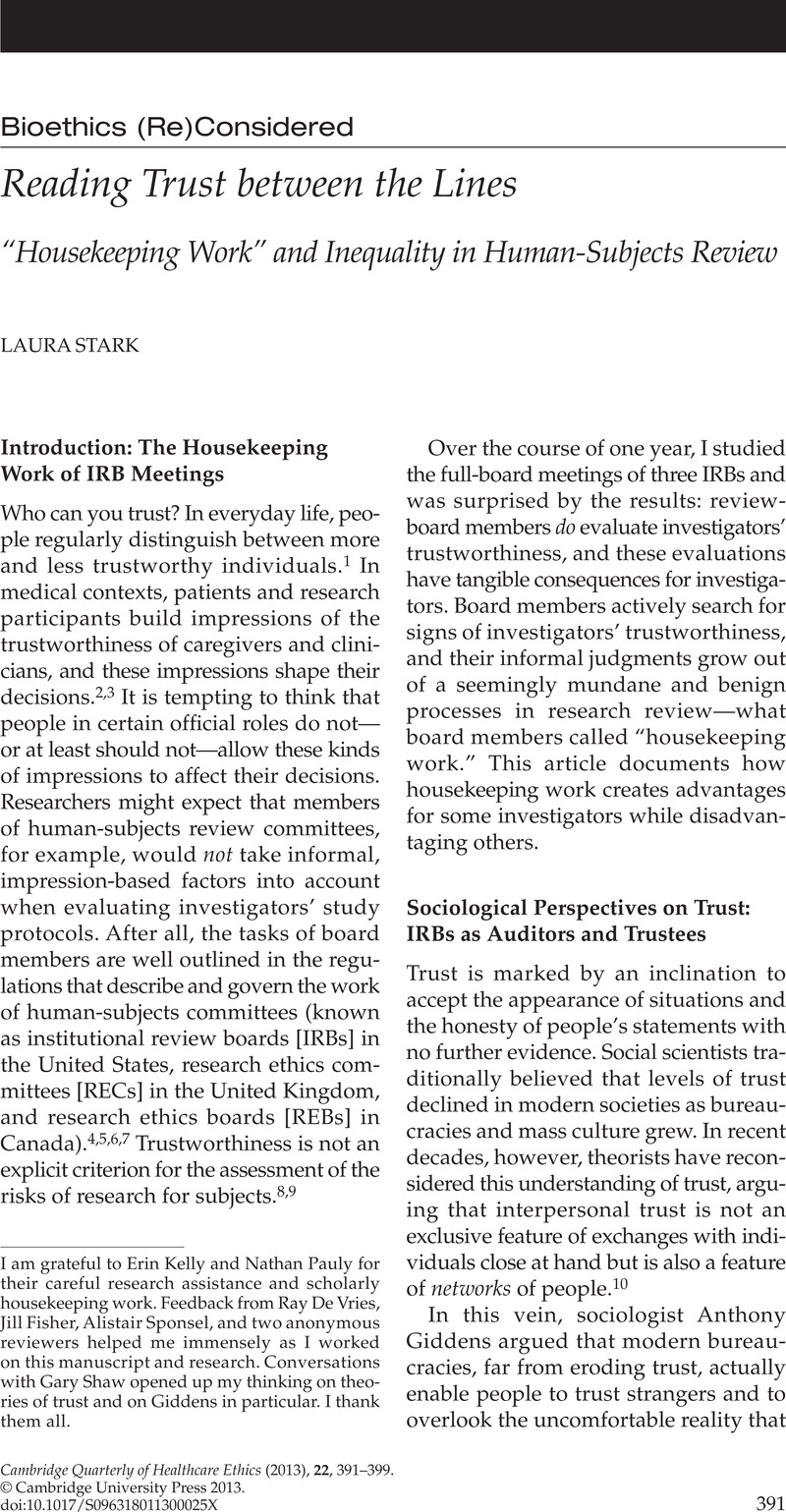“Housekeeping Work” and Inequality in Human-Subjects Review
Published online by Cambridge University Press: 16 August 2013

1. Buchan N, Croson R, Dawes R. Swift neighbors and persistent strangers: A cross-cultural investigation of trust and reciprocity in social exchange. American Journal of Sociology 2002;108:182.
2. Stepanikova1 I, Mollborn S, Cook K, Thom D, Kramer R. Patients’ race, ethnicity, language, and trust in a physician. Journal of Health and Social Behavior 2006;47(4):390–405.
3. Corbie-Smith G, Thomas SB, Williams MV, Moody-Ayers S. Attitudes and beliefs of African Americans toward participation in medical research. Journal of General Internal Medicine 1999;14(9):537–46.
4. U.S. Code of Federal Regulations, Title 45 (Public Welfare) Department of Health and Human Services, Part 46 “Protection of Human Subjects,” revised 15 Jan 2009.
5. Stark L, Hedgcoe A. A practical guide to research ethics. In: Bourgeault IL, DeVries R, Dingwall R, eds. The Sage Handbook of Qualitative Methods in Health Research. New York: Sage; 2010.
6. Heimer C, Petty J. Bureaucratic ethics: IRBs and the legal regulation of human subjects research. Annual Review of Law and Social Science 2010;6:601–26.
7. Murphy E, Dingwall R. Informed consent, anticipatory regulation and ethnographic practice. Social Science & Medicine 2007;65:2223–34.
8. Brown PR, Alaszewski A, Swift T, Nordin A. Actions speak louder than words: The embodiment of trust by healthcare professionals in gynae-oncology. Sociology of Health & Illness 2011;33:280–95.
9. Hedgecoe A. Trust and regulatory organisations: The role of local knowledge and facework in research ethics review. Social Studies of Science 2012;42(5):662–83.
10. Tilly C. Trust and Rule. New York: Cambridge University Press; 2005.
11. Giddens A. The Consequences of Modernity. Cambridge: Polity; 1990.
12. Power M. Audit Society: Rituals of Verification. Oxford: Oxford University Press; 1997.
13. Shapiro S. The social control of impersonal trust. American Journal of Sociology 1987;93(3):623–58, at 641.
14. Hoffman SG. Simulation as a social process in organizations. Sociology Compass 2007;1(2):613–36.
15. Stark L. Behind Closed Doors: IRBs and the Making of Ethical Research. Chicago: Chicago University Press; 2012.
16. National Commission for the Protection of Human Subjects of Biomedical and Behavioral Research. The Belmont Report: Ethical Principles and Guidelines for the Protection of Human Subjects of Research. Washington, DC: DHEW; 1979.
17. Hall M. The importance of trust for ethics, law, and public policy. Cambridge Quarterly of Healthcare Ethics 2005;14:156–67.
18. The National Commission for the Protection of Human Subjects of Biomedical and Behavioral Research. Appendix to report and recommendations: Institutional review boards. In: Ethical Principles and Guidelines for the Protection of Human Subjects of Research. Washington, DC: Department of Health, Education and Welfare; 1978 available at http://www.hhs.gov/ohrp/policy/belmont.html (last accessed 11 June 2013).
19. Bell J, Whiton J, Connelly S. Final Report: Evaluation of NIH Implementation of Section 491 of the Public Health Service Act, Mandating a Program of Protection for Research Subjects. Arlington, VA: James Bell; 1998, at 37.
20. DeVries RG, Forsberg CP. What do IRBs look like? What kind of support do they receive? Accountability in Research: Policies and Quality Assurance 2002;9(3–4):199–216.
21. Candilis PJ, Lidz CW, Appelbaum PS, Arnold RM, Gardner W, Myers S, et al. The silent majority: Who speaks at IRB meetings? IRB: Ethics & Human Research 2012;34(4):15–20.
22. Taylor H, Currie P, Kass N. A study to evaluate the effect of investigator attendance on the efficiency of IRB review. IRB: Ethics & Human Research 2008;30(1):1–5.